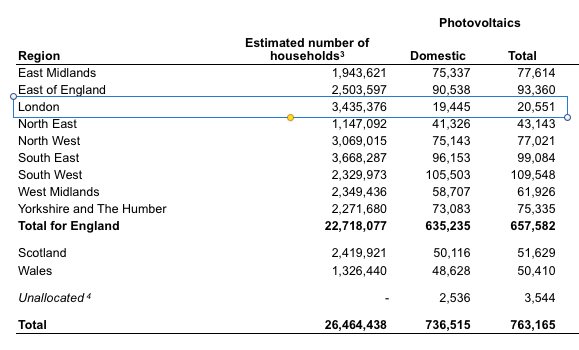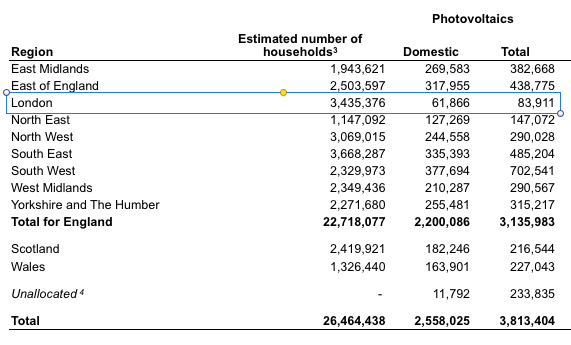Site search:
-
What’s new?
Energy for London Tags
Brent Buildings Camden Carbon Emissions CHP Cities Climate Adaptation Community Heating Community Initiatives Croydon Data DECC Decentralised Energy Distribution ECO Energy Costs Energy Efficiency Enfield FIT Fuel Poverty Funding Green Deal Hackney Haringey Housing Islington Lambeth Library Local Authorities Mayor Newham Ofgem Olympics Photovoltaics Planning RE:FIT RE:NEW Renewable Energy Retrofit Southwark Tower Hamlets Transport Waltham Forest Waste WestminsterEnergy Archives:
- February 2021 (1)
- January 2021 (15)
- December 2020 (15)
- November 2020 (9)
- October 2020 (3)
- August 2020 (5)
- July 2020 (3)
- June 2020 (4)
- April 2020 (10)
- March 2020 (5)
- February 2020 (2)
- January 2020 (3)
- October 2019 (1)
- September 2019 (4)
- August 2019 (2)
- July 2019 (1)
- August 2018 (1)
- November 2016 (8)
- October 2016 (8)
- September 2016 (2)
- August 2016 (8)
- July 2016 (14)
- April 2016 (12)
- March 2016 (16)
- February 2016 (8)
- January 2016 (4)
- December 2015 (1)
- November 2015 (1)
- October 2015 (16)
- September 2015 (3)
- June 2015 (1)
- May 2015 (1)
- April 2015 (1)
- March 2015 (1)
- February 2015 (1)
- January 2015 (1)
- December 2014 (18)
- November 2014 (4)
- August 2014 (8)
- July 2014 (7)
- June 2014 (25)
- May 2014 (8)
- April 2014 (4)
- March 2014 (12)
- February 2014 (7)
- January 2014 (13)
- December 2013 (11)
- November 2013 (15)
- October 2013 (15)
- September 2013 (18)
- August 2013 (5)
- July 2013 (20)
- June 2013 (33)
- May 2013 (8)
- April 2013 (16)
- March 2013 (25)
- February 2013 (14)
- January 2013 (20)
- December 2012 (23)
- November 2012 (23)
- October 2012 (25)
- September 2012 (14)
- July 2012 (12)
- June 2012 (43)
- May 2012 (20)
- April 2012 (8)
- March 2012 (40)
- February 2012 (39)
- January 2012 (40)
- December 2011 (22)
- November 2011 (40)
- October 2011 (33)
- September 2011 (48)
- August 2011 (40)
- July 2011 (58)
- June 2011 (41)
- May 2011 (80)
- April 2011 (38)
- March 2011 (33)
- February 2011 (25)
- January 2011 (24)
- December 2010 (3)
- November 2010 (7)
- October 2010 (6)
- September 2010 (7)
- August 2010 (1)
- July 2010 (2)
- June 2010 (4)
- May 2010 (1)
- March 2010 (3)
- February 2010 (3)
- December 2009 (5)
- November 2009 (2)
- October 2009 (3)
- July 2009 (3)
- June 2009 (1)
- April 2009 (1)
- March 2009 (1)
- February 2009 (1)
- January 2009 (1)
- December 2008 (2)
- October 2008 (1)
- September 2008 (1)
- July 2008 (1)
- March 2008 (2)
- January 2008 (2)
- October 2007 (1)
- September 2007 (3)
- July 2007 (1)
- March 2007 (1)
- February 2007 (3)
- November 2006 (3)
- August 2006 (1)
- February 2006 (1)
- May 2005 (1)
- February 2004 (1)
Renewable Energy
London Community Energy Fortnight Events
August 2016: Community Energy Fortnight starts on September the 3rd, kicking off with a major conference in Oxford. A wide number of events are taking place across the country – including a good number in London, links to which are listed below:
- 6 September Storage and Opportunities for Community Energy
- 9 September The Solar Schools Solarbration
- 12 September Community Energy Drinks
- 14 September Entrepreneurial Women in Renewables – Ginopoly
- 18 September 100% Green Energy By 2050? – How Mosques Can Help
- 21 September Pure Leapfrog LED Community Project and Workshop
Further events may come forward – check the main CEF website for further details.
Energy for London will helping at an event on 8 September with Community Energy England, Repowering London and 10:10 – initiating work for the launch of a new hub for community energy groups in London – Community Energy London. If you’re working on a community energy project, exploring a potential opportunity, or simply want to find out more information on the community energy sector in London, do come along!
Posted in Energy Efficiency, Events, News, Renewable Energy
Tagged community energy, Lighting, Schools, Street Lighting
Leave a comment
“The power revolution could soon be moving from dream to reality”
10 August 2016: Welcome to see the Evening Standard today include a major comment piece by Leo Johnson on how “Small-scale projects such as those in Newham, Brixton and Islington give a glimpse of Britain’s energy future”.
Leo highlights three projects in London as signs of how the decentralised energy model is now in the ascendancy, shifting from the “dominant energy model, the centralised production and distribution of fossil fuel-based power through the grid”.
- “In Newham, for example, the Combined Heat and intelligent Power plant (CHiP) aims to harness the energy from “fatbergs”, the bus-size balls of grease which cost Thames Water an estimated £1 million a month to remove, using teams of trained “flushers” decked out with protective white suits and shovels who descend into London’s Victorian sewer system to hack up the fat. CHiP plans to use the fat instead to power 40,000 homes.” This project is fascinating and received a lot of coverage when first announced back in 2013 – which was covered in some detail in an earlier post here – but not much further information has been forthcoming from the project on their website.
- “In Brixton, the energy group Repowering is installing solar panels on the rooftops of housing association buildings to lower fuel bills, and is teaming up with Transport for London to introduce “energy gardens” across 50 London Overground sites.” In June of this year, Repowering was awarded a prestigious Ashden Award for their work – a case study and excellent video are posted on the Ashden website here. The Energy Gardens project was covered by ITV news a few weeks ago – see video here – and more can be seen at energygarden.org.uk
- “At the Bunhill Energy Centre project in Islington, whose second phase was opened by Mayor Sadiq Khan last month, they’re using heat from the Northern line tube to power a thousand homes.” Lots more about Bunhill here.
Leo also highlights some work commissioned by the GLA by engineers Buro Happold “have estimated that there is enough heat wasted in London alone to power 70 per cent of the city’s energy needs. What’s the potential for growth? Copenhagen provides 98 per cent of its space and water heating through district heating, at 45 per cent of the cost of normal oil heating bills. London’s uptake, better than the one to two per cent national average, is currently just five per cent.” The 2013 London Secondary Heat study can be downloaded here.
Posted in Decentralised Energy, News, Renewable Energy
Tagged CHP, community energy, Community Heating, Islington, Lambeth, Newham, Photovoltaics, Waste
Leave a comment
Havering ‘Solar Parks’ Initiative
August 2016: Interesing press release from Havering issued earlier this week which stated that “Havering Council is looking to harness the power of the sun by developing solar parks on its own land to generate a significant extra income for the borough.“
“These solar parks will allow Havering to become the first borough in London to generate renewable energy on a large scale to make money, which would be used to protect and improve frontline services. Energy produced in this way is clean, sustainable and renewable.
“The land on which the solar parks will be constructed will be underused space that will result in few if any adverse effects on community usage. Once the solar park is past its useful life, the panels can be removed and the site will revert to its previous condition.”
A public consultation will be released by the council on the proposal sometime in the future.
Havering have supported solar for sometime with a range of rooftop projects across existing council buildings – and the council cites a “recent report by Greenpeace [which] placed Havering as having the second highest percentage of solar power generated by homeowners in London, with over 1100 solar panel systems installed on domestic roofs.”
Havering councillors did however turn down an application in December 2014 for a solar farm in the borough. The developer went to appeal – but national government also refused the application earlier this year.
The press release also mentions that “The proposed solar parks will also have a positive impact on local biodiversity for a range of plant and animal species, in particular broad leaved plants, grasses, wild flowers, butterflies, bees and birds. Part of the Council’s proposals would be to work with local beekeepers to promote healthy honeybee populations, as well as Britain’s rarer bumblebees, in and around the solar parks.” The National Solar Centre’s Biodiversity Guidance for Solar Developments provides further information on the ways in which solar projects can support local ecology.
Posted in Decentralised Energy, News, Renewable Energy
Tagged Havering, Photovoltaics
Leave a comment
Latest London PV statistics
August 2016: The last set of sub regional Feed in Tariff (FIT) statistics published by DECC – before it is merged with the business department into BEIS – were published last week (available here). London PV data – alongside other UK regions – is reproduced below.
Table 1. Cumulative installations confirmed on the Central Feed-in Tariff Register by Region
Table 2. Cumulative capacity confirmed on the Central Feed-in Tariff Register by Region
So – as at the end of June 2016:
- London had 20,551 PV installations (95% of which were domestic installations) with a total combined electrical generating capacity of 83.911MW.
- London’s capacity represented just 2% of total UK PV generating capacity
- The last FIT quarterly data set (for data up to the end of March 2016) reported that London had 20,123 PV installations in London and 81.623 MW – indicating a 2.28MW increase in capacity over the last three months.
Energy and Climate Questions to the Mayor
July 2016: This month Mayor’s Question Time included the following:
an update on a GLA study to evaluate the potential for the use trackside solar power production; Post Brexit, how the Mayor will use his role in the Brexit negotiating team to preserve the hard-fought environmental protections; the number of decentralised energy projects that are projected to come online this year; how the Mayor can encourage Londoners to switch energy suppliers; an estimate of the number of connections that will be provided with heat from the Beddington energy from waste plant to the Sutton Decentralised Energy Network (SDEN) – and whether Barratt Homes has signed a heat agreement with the plant’s operator, Viridor; whether the Mayor will respond to the Government’s recently released Energy Company Obligation (ECO) consultation;
work to encourage energy efficiency improvements in the private rented sector (PRS);
the RE:NEW home energy efficiency retrofit programme’s strategy over the coming year; the number of jobs linked to the green economy in London; the Mayor’s role with C40 Cities, and borough surface water management plans
Previous months questions to the Mayor can be found here.
Posted in News, Renewable Energy
Tagged Brexit, Climate Adaptation, Community Heating, Decentralised Energy, Energy Efficiency, Housing, Photovoltaics, RE:NEW, Sutton, Transport, Waste
Leave a comment
London Hydrogen Action Plan Programme Approved
July 2016: GLA approval of the London Hydrogen Action Plan funding for 2016/2017 which includes work:
“…. on delivering the London Hydrogen Action Plan (LHAP). LHAP makes the case for hydrogen investment and sets out the strategic framework and timeline (from now until 2017) for an action plan addressing vehicles and infrastructure, production and storage, stationary and early market applications. It aims to move beyond demonstrations and trials and to commercialise hydrogen and fuel cell projects that support the Mayor’s environmental, transport, social, economic and development priorities.”
Full information on the approval document can be seen on the GLA website here and further background to the London Hydrogen Action Plan at hydrogenlondon.org
Smart Cities and the Built Environment
 14 July 2016: Osborne Clark – the “smart cities law firm” – released a report last week examining how “how smart built environments leverage data, new technology and innovative and collaborative thinking to deliver services that benefit citizens”.
14 July 2016: Osborne Clark – the “smart cities law firm” – released a report last week examining how “how smart built environments leverage data, new technology and innovative and collaborative thinking to deliver services that benefit citizens”.
The report Smart cities in Europe: The future of the built environment includes a profile of the regeneration of Kings Cross: “Why is this redevelopment a good example of a smart built environment? For a start, the building utilises renewable energy. Solar
panels that generate around 10% of the
station’s energy requirements were installed
on the 2,500m² renovated train shed roof. A
combined heat and power (CHP) plant will
also provide locally generated power to new
businesses and homes on the site.”
Posted in Decentralised Energy, Library, News, Renewable Energy
Tagged Camden, CHP, community energy, Photovoltaics, smart cities
Leave a comment
City-integrated renewable energy for urban sustainability
 July 2016: A recent issue of the journal Science published a number of articles around the theme Urban Planet. One of the papers published was entitled: City-integrated renewable energy for urban sustainability (link to full text). The paper takes a high-level overview on a range of key carbon reduction opportunities at the city-level.
July 2016: A recent issue of the journal Science published a number of articles around the theme Urban Planet. One of the papers published was entitled: City-integrated renewable energy for urban sustainability (link to full text). The paper takes a high-level overview on a range of key carbon reduction opportunities at the city-level.
“To prepare for an urban influx of 2.5 billion people by 2050, it is critical to create cities that are low-carbon, resilient, and livable. Cities not only contribute to global climate change by emitting the majority of anthropogenic greenhouse gases but also are particularly vulnerable to the effects of climate change and extreme weather. We explore options for establishing sustainable energy systems by reducing energy consumption, particularly in the buildings and transportation sectors, and providing robust, decentralized, and renewable energy sources. Through technical advancements in power density, city-integrated renewable energy will be better suited to satisfy the high-energy demands of growing urban areas. Several economic, technical, behavioral, and political challenges need to be overcome for innovation to improve urban sustainability.”
Posted in Decentralised Energy, Energy Efficiency, Library, News, Renewable Energy, Uncategorized
Tagged Cities
Leave a comment
Energy and Climate Questions to the Mayor
June 2016: Positive to see the focus on energy and climate issues by a number of London Assembly members at the first question time of the new Mayor, Sadiq Khan. This month’s questions included the following issues:
the quantity of electricity supplied to TfL through the Mayor’s Licence Lite operation and few other questions on Licence Lite (here and here); supporting the growth of London community energy schemes; the London Energy Strategy; committing to London’s 25 per cent decentralised energy target; the 2020 nearly zero energy buildings target; the publication of the annual update to the GLA Energy and Climate Change Mitigation Strategy; London Energy Plan supporting studies; supporting the growth of district heating projects; support for London’s 2025 60 per cent carbon reduction target; the future of the RE:NEW and RE:FIT building retrofit programmes; the number of domestic energy efficiency retrofits supported by RE:NEW since January 2015; numbers on the GLA’s boiler scrappage list; ring fencing London’s Zero Carbon Homes offset fund; the number of zero carbon homes that could be built by 2020; zero carbon buildings planning requirements will come into force in 2019; how much money could be raised through the Zero Carbon Homes offset fund; interim targets to the Mayor’s manifesto commitment for London to be a zero carbon city by 2050; climate change and water vapour; how the Mayor will support London’s low carbon economy; emissions from river traffic (and another); zero emission cabs and PHVs abd if CO2 is a pollutant – and finally:
whether the Mayor understands “that further increases in carbon dioxide levels will not significantly increase average global temperatures due to near saturation absorption by CO2 in the 13 – 17 µm band of the infra-red spectrum”.
Previous months questions to the Mayor can be found here.
London Zero Carbon Homes Update
4 July 2016: Included in this month’s Mayor’s Questions was a series of useful queries around an announcement made earlier this year that the GLA would introduce a Zero Carbon Homes planning policy from 1 October 2016 for all new major housing developments. London’s plans to g0-ahead with a zero carbon homes policy runs counter to that of national government, where 10 years of work to introduce a 2016 zero carbon policy was scrapped by the Chancellor in his Summer Budget 2015, an announcement which was widely condemned by the building industry. A recent (unsuccessful) attempt to overturn this decision, in the passage of the Housing and Planning Bill (see here), specifically cited London’s stance as evidence of why the policy should be kept (see column 919 of the House of Lords debate – and reference to the GLA’s policy in House of Commons research paper here). The House of Commons Energy and Climate Change Select Committee also stated in their recent Home Energy Efficiency report that the “decision damaged confidence in the low carbon economy and will lock in the requirement for future wide-scale energy efficiency measures and costly retrofits. We recommend that the Government reinstates the zero carbon homes policy or sets out a similar policy that will ensure that new homes generate no net carbon emissions.”
The Mayor’s responses clarified that:
- Funds raised through the London zero carbon homes offset fund need to be ring-fenced by local councils
- It’s not clear at the moment how much funding will be raised for low carbon projects through the offset funds, but money has already been collected by early adopters of the policy
- That the zero carbon policy will be extended to non-residential buildings from 2019
- It’s also not clear how many zero carbon homes will be built by 2020.
The GLA has also approved research work of the various approaches that could be taken by local authorities to direct these offset funds to. The outline of this research project states that:
‘London Plan policy 5.2 sets out that where the target percentage improvements in carbon dioxide emissions beyond Part L of the Building Regulations cannot be met on-site, any short fall should be provided off-site or through cash in lieu contribution to the relevant borough. This is to be ring fenced to secure delivery of carbon dioxide savings elsewhere.
Existing London Plan policy was prepared in expectation of the establishment of a national zero carbon homes and associated ‘allowable solutions’ framework which the national government is no longer progressing. As such, for the short to medium term it is likely that carbon offset funds established by borough’s will remain the only manner for securing carbon offset funding where development is unable to viably or feasibly meet carbon dioxide emissions reduction targets on-site. As such there is a need to gain a more detailed understanding of the diversity of approaches London boroughs are currently taking to carbon offsetting in order to best inform any future GLA actions in this policy area. This work forms the first stage of the information-gathering and data analysis of this process. “
It’s great to see London leading in this area to ensure that – as the Chair of the Energy and Climate Change Committee has recently said – we are “building houses that are fit for the future. We have the technology and building techniques to construct houses that generate their own power and hardly need heating. We owe it to future generations to use them.”
Posted in Decentralised Energy, Energy Efficiency, News, Renewable Energy
Tagged Planning
Leave a comment
The UK’s first solar bus shelter opens in Canary Wharf
11 April 2016: “The UK’s first solar power generating bus stop has been opened in Canary Wharf. Designed by Polysolar Ltd it is made with transparent photovoltaic glazing, which captures the sun’s rays even in low light. It was unveiled on Friday, April 8, outside the HSBC building in Canada Square by London Mayoral candidate Sian Berry.” Read the full story in The Wharf – with more on this story at Gizmag.
Nearly three quarters of Londoners want next Mayor to back solar
11 April 2016: Results of a Greenpeace poll published today – “A poll of 1007 people carried out by Mora consulting found that 73.2% of Londoners (and 70% of undecided voters) thought it was either very or quite important that the next mayor take steps to make London a leading city for solar power.” Read the full story on the results here.
This builds on a report published by Greenpeace UK – undertaken by Energy for London – on potential London solar initiatives for an incoming Mayor.



